Related Research Articles

The Institute for Theoretical and Experimental Physics is a multi-disciplinary research center located in Moscow, Russia. ITEP carries out research in the fields of theoretical and mathematical physics, astrophysics, high energy particle physics, nuclear physics, plasma physics, solid state physics, nanotechnology, reactor and accelerator physics, medical physics, and computer science. ITEP also maintains an extensive educational program and organizes physics schools for scholars and undergraduates. The institute is located near the corner of the Sevastopol prospect and the Nachimowski prospect and occupies part of the former estate "Cheryomushki-Znamenskoye" - an 18th-century manor that is a monument of architecture and landscape art of the 18th-19th centuries.

David Jonathan Gross is an American theoretical physicist and string theorist. Along with Frank Wilczek and David Politzer, he was awarded the 2004 Nobel Prize in Physics for their discovery of asymptotic freedom. Gross is the Chancellor's Chair Professor of Theoretical Physics at the Kavli Institute for Theoretical Physics (KITP) of the University of California, Santa Barbara (UCSB), and was formerly the KITP director and holder of their Frederick W. Gluck Chair in Theoretical Physics. He is also a faculty member in the UCSB Physics Department and is currently affiliated with the Institute for Quantum Studies at Chapman University in California. He is a foreign member of the Chinese Academy of Sciences.

Tata Institute of Fundamental Research (TIFR) is an Indian Research Institute under the Department of Atomic Energy of the Government of India. It is a public deemed university located at Navy Nagar, Colaba in Mumbai. It also has campus in Bangalore, International Centre for Theoretical Sciences (ICTS), and an affiliated campus in Serilingampally near Hyderabad. TIFR conducts research primarily in the natural sciences, the biological sciences and theoretical computer science.
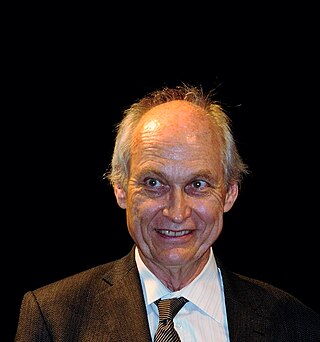
Michael S. Turner is an American theoretical cosmologist who coined the term dark energy in 1998. He is the Rauner Distinguished Service Professor Emeritus of Physics at the University of Chicago, having previously served as the Bruce V. & Diana M. Rauner Distinguished Service Professor, and as the assistant director for Mathematical and Physical Sciences for the US National Science Foundation.
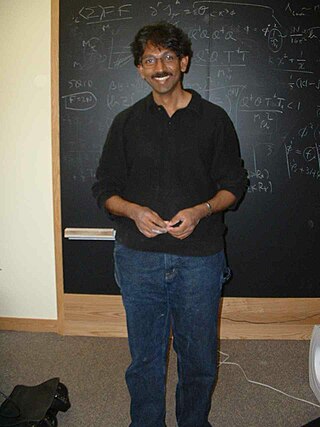
Raman Sundrum is an Indian-American theoretical particle physicist. He contributed to the field with a class of models called the Randall–Sundrum models, first published in 1999 with Lisa Randall. Sundrum is a Distinguished University Professor at the University of Maryland and the director of Maryland Center for Fundamental Physics.
The MIT Center for Theoretical Physics (CTP) is the hub of theoretical nuclear physics, particle physics, and quantum information research at MIT. It is a subdivision of MIT Laboratory for Nuclear Science and Department of Physics.
The Stanford Institute for Theoretical Physics (SITP) is a research institute within the Physics Department at Stanford University. Led by 16 physics faculty members, the institute conducts research in High Energy and Condensed Matter theoretical physics.
The Institute for High Energy Physics of Barcelona, Spain, is a Public Consortium between the Generalitat de Catalunya and the Universitat Autònoma de Barcelona (UAB). It was formally created on July 16, 1991, by Act number 159/1991 of the Generalitat. As an organization it is independent from both the UAB and the Generalitat, ruled by its own Statutes, and governed by a Governing Board. It is located on the campus of UAB in Bellaterra, Barcelona.
Alexei Yuryevich Smirnov is a neutrino physics researcher and one of the discoverers of the MSW Effect.
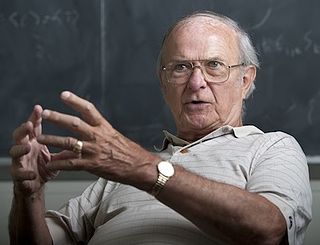
Carl Richard Hagen is a professor of particle physics at the University of Rochester. He is most noted for his contributions to the Standard Model and Symmetry breaking as well as the 1964 co-discovery of the Higgs mechanism and Higgs boson with Gerald Guralnik and Tom Kibble (GHK). As part of Physical Review Letters 50th anniversary celebration, the journal recognized this discovery as one of the milestone papers in PRL history. While widely considered to have authored the most complete of the early papers on the Higgs theory, GHK were controversially not included in the 2013 Nobel Prize in Physics.
The Hans A. Bethe Prize, is presented annually by the American Physical Society. The prize honors outstanding work in theory, experiment or observation in the areas of astrophysics, nuclear physics, nuclear astrophysics, or closely related fields. The prize consists of $10,000 and a certificate citing the contributions made by the recipient.
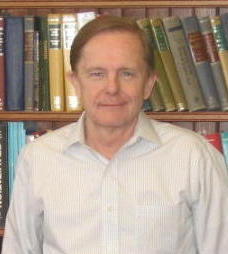
Thomas William Appelquist is a theoretical particle physicist who is the Eugene Higgins Professor of Physics at Yale University.
The William I. Fine Theoretical Physics Institute is a research institute in the University of Minnesota College of Science and Engineering. FTPI was largely the work of physics Professor Emeritus, Stephen Gasiorowicz and university alumnus and Twin Cities real-estate developer William I. Fine. The institute officially came into existence in January 1987. FTPI faculty consists of six permanent members: Andrey V. Chubukov, Alex Kamenev, Keith Olive, Maxim Pospelov, Mikhail Shifman, and Boris Shklovskii.
Bryan Ronald Webber, FRS, FInstP is a British physicist and academic. He was a Fellow of Emmanuel College, Cambridge from 1973 to 2010, and Professor of Theoretical Physics at the University of Cambridge from 1999 to 2010. He has been awarded the Dirac Medal by the Institute of Physics, the Sakurai Prize by the American Physical Society and the High Energy and Particle Physics Prize by the European Physical Society.

Tracy Robyn Slatyer is a professor of particle physics with a concentration in theoretical astrophysics with tenure at MIT. She was a 2014 recipient of the Rossi Prize for gamma ray detection of Fermi bubbles, which are unexpected large structure in our galaxy. Her research also involves seeking explanations for dark matter and the gamma ray haze at the center of the Milky Way. In 2021, she was awarded a New Horizons in Physics Prize for "major contributions to particle astrophysics, from models of dark matter to the discovery of the "Fermi Bubbles."

Vassiliki Kalogera is a Greek astrophysicist. She is a professor at Northwestern University and the Director of the Center for Interdisciplinary Exploration and Research in Astrophysics (CIERA). She is a leading member of the LIGO Collaboration that observed gravitational waves in 2015.
Michael Dine is an American theoretical physicist, specializing in elementary particle physics, supersymmetry, string theory, and physics beyond the Standard Model.
Howard Eli Haber is an American physicist, specializing in theoretical elementary particle physics.
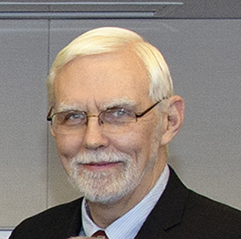
G. Peter Lepage is a Canadian American theoretical physicist and an academic administrator. He was the Harold Tanner Dean of the College of Arts and Sciences at Cornell University from 2003 to 2013.
Cora Dvorkin is an Argentine physicist, who is a professor at the physics department at Harvard University. Dvorkin is a theoretical cosmologist. Her areas of research are: the nature of dark matter, neutrinos and other light relics, and the physics of the early universe. Dvorkin is the Harvard Representative at the newly NSF-funded Institute for Artificial Intelligence and Fundamental Interactions (IAIFI)'s Board. In 2022, she was voted “favorite professor” by the Harvard senior Class of 2023. She has been awarded the 2019 DOE Early Career award and has been named the "2018 Scientist of the year" by the Harvard Foundation for "Salient Contributions to Physics, Cosmology and STEM Education". She has also been awarded a Radcliffe Institute Fellowship and a Shutzer Professorship at the Radcliffe Institute. In 2018 she was awarded a Star Family Challenge prize for Promising Scientific Research, which supports high-risk, high-impact scientific research at Harvard. In 2020, Dvorkin gave a talk on machine learning applied to the search for dark matter as part of the TEDx Río de la Plata event.
References
- ↑ "Welcome to SCIPP". scipp.ucsc.edu. Retrieved 2020-01-10.
- ↑ "SCIPPers". scipp.ucsc.edu. Retrieved 2020-01-10.
